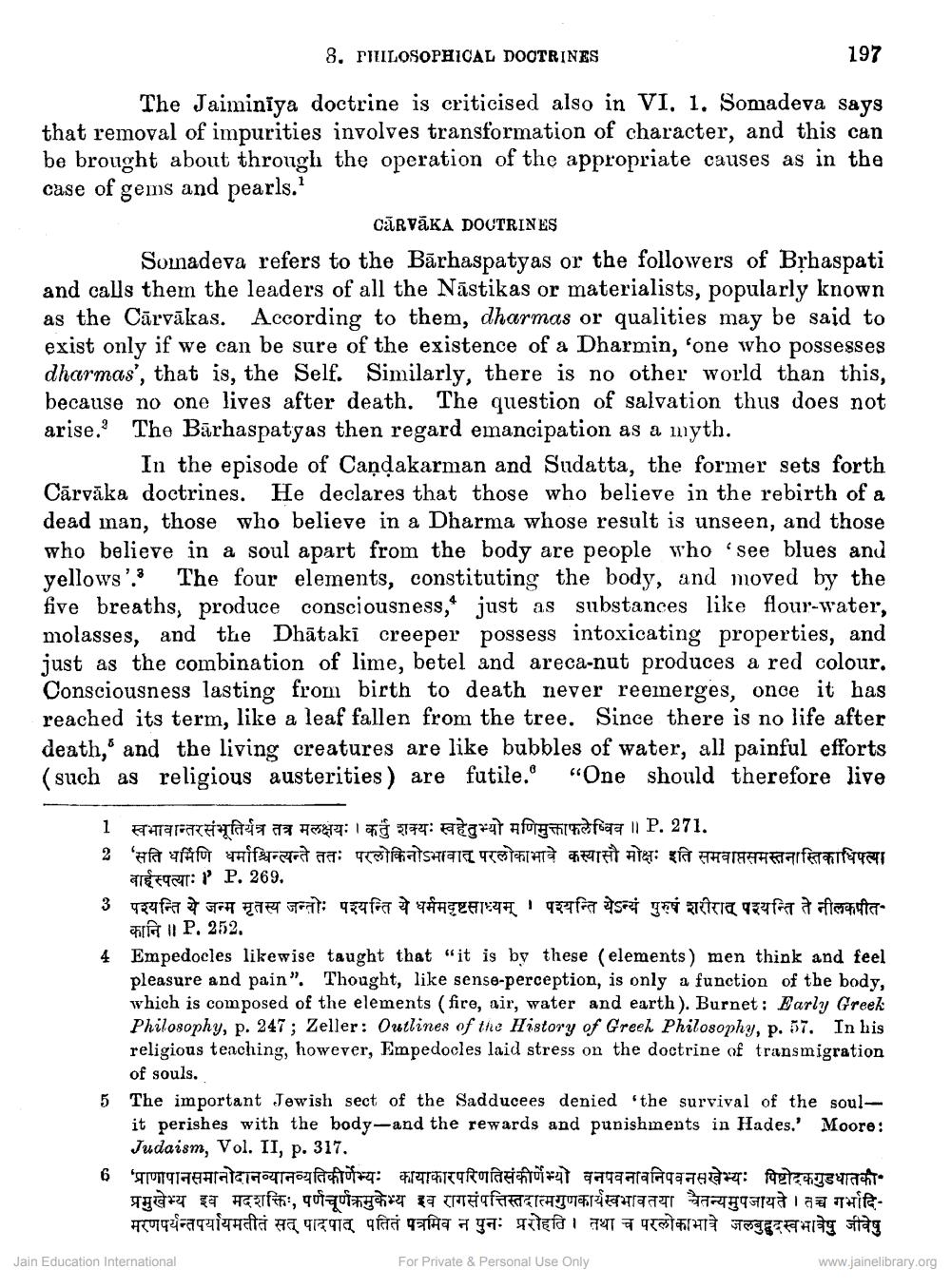________________
8. PIILOSOPHICAL DOCTRINES
197
The Jaiminiya doctrine is criticised also in VI. 1. Somadeva says that removal of impurities involves transformation of character, and this can be brought about through the operation of the appropriate causes as in the case of gems and pearls.?
CĀRVĀKA DOCTRINES Somnadeva refers to the Bărhaspatyas or the followers of Brhaspati and calls them the leaders of all the Nāstikas or materialists, popularly known as the Cārvākas. According to them, dharmas or qualities may be said to exist only if we can be sure of the existence of a Dharmin, 'one who possesses dharmas', that is, the Self. Similarly, there is no other world than this, because no one lives after death. The question of salvation thus does not arise. The Bārhaspatyas then regard emancipation as a myth.
In the episode of Caņdakarman and Sudatta, the former sets forth Cārvāka doctrines. He declares that those who believe in the rebirth of a dead man, those who believe in a Dharma whose result is unseen, and those who believe in a soul apart from the body are people who see blues and yellows'.3 The four elements, constituting the body, and moved by the five breaths, produce consciousness, just as substances like flour-water, molasses, and the Dhātaki creeper possess intoxicating properties, and just as the combination of lime, betel and areca-nut produces a red colour. Consciousness lasting from birth to death never reemerges, once it has reached its term, like a leaf fallen from the tree. Since there is no life after death, and the living creatures are like bubbles of water, all painful efforts (such as religious austerities) are futile. "One should therefore live
1 Fara faza 2 : 1 77: Tout Aforinfaa || P. 271. 2 'सति धर्मिणि धर्माश्चिन्त्यन्ते ततः परलोकिनोऽभावात् परलोकाभावे कस्यासौ मोक्षः इति समवाप्तसमस्तनास्तिकाधिपत्या
ang : 1 P. 269. 3 पश्यन्ति ये जन्म मृतस्य जन्तोः पश्यन्ति ये धर्ममदृष्टसाध्यम् । पश्यन्ति येऽन्यं पुरुष शरीरात् पश्यन्ति ते नीलकपीत
FIP. 252. 4 Empedocles likewise taught that "it is by these (elements) men think and feel
pleasure and pain". Thought, like sense-perception, is only a function of the body, which is composed of the elements (fire, air, water and earth). Burnet: Barly Greek Philosophy, p. 247; Zeller: Outlines of the History of Greeh Philosophy, p. 57. In his religious teaching, however, Empedocles laid stress on the doctrine of transmigration
of souls. 5 The important Jewish sect of the Sadducees denied the survival of the soul
it perishes with the body-and the rewards and punishments in Hades.' Moore: Judaism, Vol. II, p. 317. 'प्राणापानसमानोदानव्यानव्यतिकीर्णेभ्यः कायाकारपरिणतिसंकीर्णेभ्यो वनपवनावनिपवनसखेभ्यः पिष्टोदकगुडधातकी. प्रमुखेभ्य इव मदशक्तिः, पर्णचूर्णक्रमुकेभ्य इव रागसंपत्तिस्तदात्मगुणकार्यस्वभावतया चैतन्यमुपजायते । तच्च गर्भादिमरणपर्यन्तपर्यायमतीतं सत् पादपात् पतितं पत्रमिव न पुनः प्ररोहति । तथा च परलोकाभावे जलबुद्दस्वभावेषु जीवेषु
Jain Education International
For Private & Personal Use Only
www.jainelibrary.org




